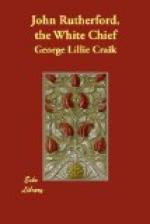Near the end of the narrative, Rutherford gives an account of a great battle, in which the chief Hongi was a prominent figure. His description of what took place is incorrect in several respects. Victory went to Hongi, not, as Rutherford says, to the people of Kaipara and their allies, although they were victorious in the first skirmish. The battle is known as Te Ika-a-rangi-nui, that is the Great Fish of the Sky or the Milky Way, and it took place in February, 1825. As Rutherford states, Hongi was present, and wore the famous coat of mail armour which had been given to him by His Majesty King George IV. when he was in England in 1820. The strife was caused not by an attempt to steal Hongi’s armour, as Rutherford suggests, but by a thirst for revenge for the death of a chief of the Nga-Puhi tribe, to which Hongi belonged. The chief Whare-umu, evidently identical with “Ewarree-hum” in Rutherford’s narrative, did not belong to the party that Rutherford was connected with; he was related to the man whose murder was avenged, and seems to have been Hongi’s first lieutenant. Some authorities, notably Bishop Williams, of Waiapu,[B] and Mr. Percy Smith,[C] believe that Rutherford was not present at the battle, and that he obtained all his information from others. Bishop Williams, who knows the Poverty Bay district as well as anyone, has come to the conclusion that Rutherford must have spent his years in New Zealand in the Bay of Islands district; and Mr Percy Smith, in a letter to me, says that he has always entertained the idea that Rutherford was one of the men taken when the schooner “Brothers” was attacked at Kennedy Bay in 1815. Bishop Williams sets up the theory that Rutherford was a deserter from a vessel which visited New Zealand, that he induced the Maoris to tattoo him in order that he might escape detection after he had returned to civilization, and that he concocted the story of the capture of the “Agnes” to account for his reappearance amongst Europeans. The weakness of this theory is that he evidently did not object to publicity, and that the tattooing would make him a conspicuous man who could not avoid public attention. If Bishop Williams is right in assuming that Rutherford wished to escape detection, he took the very best course to defeat his object.




